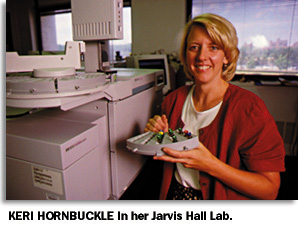 How potentially toxic organic chemicals get distributed around the world is the focus of her work. Much of her past research has concentrated on water bodies and how toxic chemicals can accumulate in the Great Lakes in particular.
How potentially toxic organic chemicals get distributed around the world is the focus of her work. Much of her past research has concentrated on water bodies and how toxic chemicals can accumulate in the Great Lakes in particular.
By DONNA STEINBERG
Reporter Contributor
 How potentially toxic organic chemicals get distributed around the world is the focus of her work. Much of her past research has concentrated on water bodies and how toxic chemicals can accumulate in the Great Lakes in particular.
How potentially toxic organic chemicals get distributed around the world is the focus of her work. Much of her past research has concentrated on water bodies and how toxic chemicals can accumulate in the Great Lakes in particular.
She is investigating atmospheric processes, "because atmospheric processes tend to be an important part of getting those chemicals distributed globally as well as distributed regionally as in the Great Lakes region.
"Most of the chemicals I'm studying are anthropogenic, produced by human activity. Many are harmful to developing animals, are endocrine disruptors, or are possible carcinogens. The problem is that figuring out where and how to reduce their inputs is difficult," Hornbuckle said. "Most of these compounds have non-point sources.
"It may be that incinerators and fossil fuel burners are at fault, and that's all of us. We haven't regulated them with respect to polluting lakes. Better understanding of the exchange of these chemicals between air and earth's surfaces is required. For example, just looking at the air alone, one can't determine the ultimate fate of atmospheric pollutants," she said.
In her current research, "I'm interested in how organic chemicals are deposited in water surfaces and how they're degased from water. The other half of the same question, really, looks at non-water sources, such as forest, or grasslands or peatlands.
"The same kind of mechanisms work in both places, but the way we model the exchange of chemicals is different," Hornbuckle said.
"I go out to a site and measure these chemicals, in air and in water and in particles," along with gathering a lot of meterological information.
Her research tries to get a handle on the mechanisms that control whether these potentially toxic compounds will be deposited or released.
She also is pursuing how organic chemicals get deposited on plant surfaces and then transferred somewhere else.
"We think that plants may act as sources for these compounds in the environment not just by volatilizing, but also when leaves fall off trees and into tributaries, for instance." The result would be to deliver atmospheric pollutants into tributaries, becoming non-point sources for these toxics to the lakes, Hornbuckle said.
Her latest research could help to explain earlier studies showing that even when there are no toxic dumps or other contaminants in the water of a tributary, there still are sources of toxic chemicals.
"We hypothesize that that's really an atmospheric signal. The mechanism by which the atmosphere delivers them to the tributaries may be mostly driven by uptake by plants, especially when you're not talking about tilled land, where erosion is a factor."
One of her students is studying this process in a small tributary near Machias, where she has found that, indeed, chemicals that are delivered to plants through the atmosphere do end up in the tributary. This work was funded as a multidisciplinary pilot project from the provost's office.
"It's difficult for us to quantify, but they are a source of polycyclic aromatic hydrocarbons, which are released mostly from fossil fuel burning" into the air, by gas exchange or by particle fallout.
'We studied a place in southwestern New York that's pretty far from any known sources of these particles. We think that what we're seeing is a result of gas exchange."
She pointed out that the concentrations at this level are so low they are not toxic, but only become toxic as they bioaccumulate in animals.
"We're really interested in the non-point sources into the lakes, because that will accumulate in fish, which then become a hazard to humans. The tributaries are an important source of chemicals to the lake."
Her other big project was funded by the Environmental Protection Agency, which asked her to look at direct deposition from the air to Lake Michigan's surface area.
"It's driven in part by our desire to know when we can start to use the Great Lakes as commercial fisheries again. Right now we're prohibited from doing that by the accumulations of toxins in the fish. It turns out the atmosphere is a really important pathway for the deposition and release of these chemicals, and so understanding the atmospheric portion of the model is critical for predicting what's going to happen over time.
"Twenty years ago, everybody was quite sure that eventually PCBs would be all gone and buried in the bottom mud. Now we've changed our minds completely.
"These compounds aren't really going away. They're continuing to be put into the air and then they can go somewhere else, which means that they have a lot longer residence time in ecosystems than we had expected."
Hornbuckle, who earned her Ph.D. from the Department of Civil Engineering at the University of Minnesota, recently was awarded a National Science Foundation grant to examine the effect of climate on the distribution of persistent organic compounds between terrestrial plants and the atmosphere. Her project has been funded for four years by the NSF's Faculty Early Career Development program.